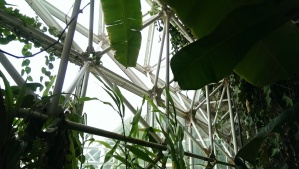The first time I saw the Biosphere 2 space frame structure, it reminded me of a giant jungle gym. Actually, every time I see Biosphere 2, it looks like a giant jungle gym. I’m sure I’m not the only one who stares at it, imagining how to to climb it.
It’s just that I finally got to.


In my last post, I wrote about a summer excursion to the Brazilian Amazon to help with research on the future of the Amazon under climate change. I was helping Neill Prohaska and other members of Scott Saleska’s lab and the GO Amazon project measure seasonality and reflectance of leaves, which is part of a larger effort to understand what would happen if the climate there gets hotter and drier.

But back in the early 1990’s, Biosphere 2’s original builders included a tropical rainforest in their structure. Now researchers can do the experiment by creating a drought for an entire stand of living rainforest trees, which is tricky to do in the Amazon. In fact, they kind of already have.
Over the years, as the facility changed hands, it experienced a gap during hot Arizona summers with virtually no air conditioning or rainfall – an extreme version of climate change. Another member of Scott’s lab, Ty Taylor, has analyzed the concurrent change in the tree species remaining. (I should point out that the species in B2’s forest are not all Amazonian, but from around the world, so it’s not a perfect analog in several ways.)
But Dr. Joost van Haren wants to know what happens to individual trees and to the system’s ability to photosynthesize and grow, storing carbon dioxide from the air, during a drought. So for the last 8 weeks, the B2 tropical rainforest has experienced a drought. This weekend, I was part of a small team that helped take some vital rates of photosynthesis activity in the rainforest.
By far the most exciting part was the pre-dawn climb up through the space frame to cut sample branches. I was actually not helpful at all in this part – Neill scampered around the structure like a capuchin, while I moseyed upwards comparatively like a sloth. I didn’t cut a single branch.
It turns out when you approach the space frame closely, the struts are a little bigger than your school yard jungle gym, a little slicker with condensation (even during the drought they were a little wet), a little more likely to be covered in vines to catch you…. and the whole thing is a little bit taller.
And while we used harnesses and safety devices that clipped to these struts, these static lines would hurt to fall on, even if you didn’t break a bone hitting the bars of the frame on your way down.
“Don’t fall,” Neill told me. Eek!
I didn’t fall, even climbing all the way to the top of the rainforest section to watch the sunrise, where a bird flew in through an open vent and perched on the struts nearby.
If YOU haven’t seen the rainforest for a while, you should join me some Saturday evening in October out at Biosphere 2 for pizza, live animals, telescopes, and more. This is a shameless plug, since I’m helping to coordinate these Discovery Nights, as the late evening events are called, but seriously, you should get some friends together and go. I’ll be at all three. There will be live animals, fossils or meteorites, telescopes, and the chance the wander through B2 in the dark at your own pace instead of with a large tour. Oh, and your admission fee includes an annual pass on those nights. And kids are free. (If YOU want to get in free as well, you can volunteer all evening! Send me an email ASAP if you want in.)
Check out the details and dates at http://www.b2science.org.





